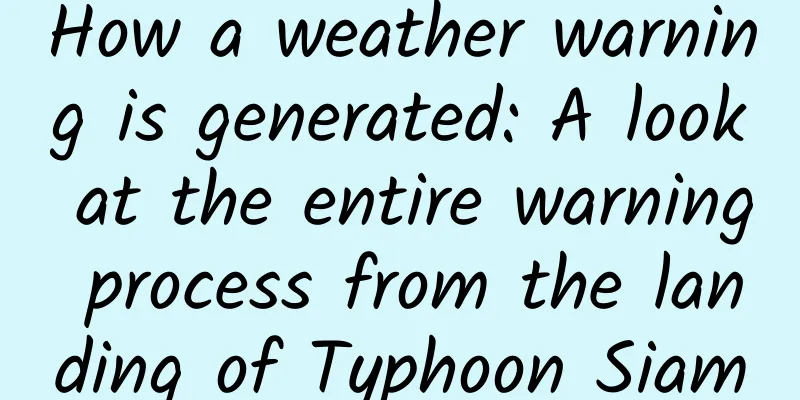How a weather warning is generated: A look at the entire warning process from the landing of Typhoon Siam

|
In recent days, under the influence of Typhoon Siam, tornadoes have frequently visited many places in Guangdong. At around 15:30 on July 4, a medium-level tornado occurred near Yundonghai Street, Sanshui District, Foshan City, causing tree branches to break and factory sheds to be damaged. On the same day, the Foshan Meteorological Observatory issued a tornado alert one hour in advance, buying precious time for local disaster prevention and personnel evacuation. How do "life-saving" weather warnings get to us? Recently, reporters visited relevant units of the China Meteorological Administration to explore the scientific and technological support behind the first line of defense for meteorological disaster prevention and mitigation. A steady stream of first-hand observation data is transmitted to the numerical model in a timely manner In recent years, extreme weather disasters such as short-term heavy rainfall and tornadoes have occurred frequently around the world, causing serious damage to people's lives and property. Radar and satellite data analysis is an important technical support for my country's forecasting business. Back to the afternoon of June 26, a tropical disturbance took advantage of the "gap" left by the subtropical high pressure moving westward and northward on the tropical ocean surface and began to grow. A few days later, it grew into the first typhoon "Siam" to land in my country this year, and after landing, it moved northward, bringing abundant rain. At that time, looking at the slightly broken and asymmetrical spiral shape on the satellite cloud map, it was difficult to predict its future. However, experienced forecasters have paid full attention to it because its location - the sea east of the Philippine Islands - is an important source of typhoons affecting my country. Relying on satellite cloud images, forecasters can intuitively understand the general trend of the weather system, but accurate forecasting work must be based on precise observation data. my country has the world's largest comprehensive meteorological observation system, with more than 70,000 automatic weather stations, 236 radars, more than 120 sounding stations, and 7 in-orbit Fengyun meteorological satellites, which together form an integrated ground-air-space observation network that can not only capture weather dynamics in the first place, but also accurately measure minute-level or even second-level precision data behind wind and cloud movement. Abstracting the concrete typhoon into data such as air pressure, temperature, wind direction, and wind speed is very important for modern weather forecasting. Over the past century, meteorologists have summarized the laws of atmospheric movement into a set of equations. Today, supercomputers are used to obtain approximate numerical solutions to these equations - this is numerical forecasting. Since its birth, numerical forecasting has undergone more than half a century of development, and its accuracy and timeliness have been qualitatively improved. It is also known as one of the greatest scientific and technological achievements of the 20th century. It can effectively predict weather changes in the next 7 days or so, and its validity period is extended by one day every 10 years. Now let's turn our attention back to Typhoon Siam. Its data are continuously gathered from various observation instruments to the meteorological big data cloud platform, undergoing transmission, quality control, aggregation, and analysis... People pass the first-hand observation data to the numerical model, and expect it to calculate results that are as close to reality as possible. Numerical models can provide forecasts, but forecasters cannot rest easy "'Siam Ba' will move northwestward at a speed of 10 to 15 kilometers per hour... and will make landfall on the coast from eastern Hainan Island to western Guangdong from July 2 to 3, with a landfall intensity of tropical storm or severe tropical storm level." On June 30, "Siam Ba" was upgraded to a tropical storm and officially named. This is the forecast conclusion of the Central Meteorological Observatory on that day. Behind these few simple lines, there are not only the calculations of numerical models, but also the hard work of forecasters. In fact, numerical forecasting is best at predicting the general development of weather systems many days in advance, such as the general direction of a typhoon or when large-scale rainfall will occur. However, it is impossible to accurately predict the specific path of a typhoon and how much rainfall will fall in a certain place. This requires forecasters to revise the forecast conclusions to be as close to reality as possible. During the forecasting process of "Siam Ba", forecasters from the Central Meteorological Observatory, Guangdong, Guangxi, Hainan, Hong Kong, Macao and other places analyzed various information, studied various data, compared the correctness of various subjective and objective forecasts in the past, and often gathered together to discuss and study, and finally came to the forecast conclusion. Moreover, as the weather system continues to change, this forecast conclusion must also be updated in a timely manner. The forecast conclusion is based on science, and the transformation from forecast to warning also has to go through a rigorous process. Data is still the core standard of this process. According to the "National Meteorological Disaster Emergency Plan", the forecast value obtained by research and judgment is compared with the critical value of the warning level standard set in advance through research. When the conditions are met, the corresponding type and level of meteorological warning will be issued. Zhang Tao, chief forecaster of the National Meteorological Center, told reporters that the warning issued by the Central Meteorological Observatory is a kind of prospective warning. For example, when predicting a thunderstorm, it is simulated through algorithms, which is a simulation of the future. In any case, it is only an approximation. It is normal to have errors, but how to overcome the problem under the limitations is the mission of the forecaster. The core task of the forecaster is to improve the accuracy and refinement of weather forecasts. Whether the “last mile” is smooth or not is related to the effectiveness of disaster prevention Every piece of warning information must go through a "must-go" path, which is the national warning information release system. As part of the national emergency command platform system, the national emergency warning information release system has established four-level warning information release centers at the national, provincial, municipal and county levels. The warning public coverage rate exceeds 80%, and the warning release time is 3 to 8 minutes. It can be sent to the disaster prevention responsible persons in the affected areas within 1 minute. At 10:00 on June 30, the Central Meteorological Observatory issued a blue typhoon warning, pointing out the areas affected by "Siam Ba". Although the warning was issued, the work of the meteorological department was far from over. "We are like doctors. Forecasting the weather is like being on duty to see patients. Weather conditions such as wind, rain, thunder and fog are like the different diseases faced by doctors in different departments." Zhang Tao introduced that, on the one hand, forecasts and warnings need to be updated at any time; on the other hand, the warnings issued by the Central Meteorological Observatory have a large scope and wide coverage, which is mainly based on the impact of typhoons on the whole country, and focuses on reminding relevant departments to make emergency preparations. From the time a warning is released to the time it is delivered to the affected population, the time left for people to take disaster prevention and mitigation measures is often only a few hours or even dozens of minutes. In this limited and precious time, whether the "last mile" of meteorological warning information can be smoothly delivered directly affects the effectiveness of disaster prevention and mitigation. If Typhoon Siam comes ashore, the staff of the Typhoon and Ocean Forecast Center will produce real-time analysis, situation forecasts, coastal sea area forecasts, offshore sea area forecasts, offshore sea area forecasts, maritime bulletins, marine weather bulletins, marine weather warnings and other products based on various local monitoring data, and release them through websites, television, radio and other media. This seemingly trivial job is extremely important and tests the ability of grassroots meteorologists to grasp the weather according to local conditions. During the impact of "Siam Ba", under the wings of the typhoon with an impact range of thousands of kilometers, there are also tornadoes with an activity area of only a few kilometers, which appear and disappear in tens of minutes to hours. They appear in many places such as Guangzhou, Foshan, Chaozhou, and Shantou. It is a difficult problem worldwide to make accurate and timely forecasts and warnings for these destructive "small ones". The meteorological department made an attempt - at 14:30 on July 4, the Foshan Meteorological Observatory issued a special tornado alert down to the town and street level: "It is predicted that there may be tornadoes in the southwest of Sanshui, Yundonghai, and Leping within two hours. Please organize defense immediately, especially owners of factory roofs and buildings with poor wind resistance should organize the evacuation of personnel as soon as possible." This move won precious time for responding to the tornado. From observing the movement of large-scale weather systems such as subtropical high pressure to capturing the birth and disappearance of extremely small-scale weather systems such as tornadoes, the birth of an early warning is inseparable from the accumulation of science and technology, experience, close linkage of comprehensive observation systems, and the investment in numerical forecasting, a "national heavy weapon". In Zhang Tao's view, it is also necessary to reach every tiny corner with services, and to face the reality that it is impossible to make a 100% accurate forecast with 100% courage and enthusiasm. Our reporter Cui Xingyi and our correspondent Liu Zhao Source: Guangming Daily |
<<: This flower in Qinling Mountains has been playing hide-and-seek with humans for 100 years
>>: Is it true that the “super collider” is about to be built in Qinhuangdao?
Recommend
Qinghai: Protecting the beautiful background of China's water tower and surging "green energy" in the sky
What is Qinghai? It is the source of the Yangtze ...
Hospital bidding promotion plan, what does hospital bidding promotion mean?
Bidding promotion is charged according to the num...
Baidu promotion Juping advertising delivery mode, targeting method, and selling price!
1. Delivery 1) What are the different modes of Ju...
World Health Organization: There will be about 20 million new cancer cases worldwide in 2022, including 2.5 million new lung cancer cases
The International Agency for Research on Cancer u...
How to get started with user operations in 4 steps?
I believe that those who are engaged in operation...
The four magic weapons for good APP promotion: armor, weapons, martial arts, and war horses
1. What is Internet Promotion? Promoters use the ...
Zhu Baiban: "How to Create an Account for Live Streaming"
Zhu Baiban's resource introduction of "Ho...
How does the blood in the legs and feet overcome gravity and flow to the heart?
Who can fight against the gravity of the earth? B...
The latest notice on leaving and entering Beijing today in March 2022: Is it necessary to do a nucleic acid test within 72 hours after entering Beijing?
In recent days, there have been new cases of epid...
One article to understand Toutiao advertising placement
" Toutiao " is a personalized recommend...
Baidu bidding is not effective. What is the reason?
Baidu bidding is not effective. What is the reaso...
What is the relationship between Thunderbolt 3 and USB Type-C on Apple's new MacBook?
After releasing the iPhone 7, Apple's latest m...
Caisen Technology Class Video-Sencai Technology 10 minutes a day investment is easy in 2021
Cai Sen Technology Class Video-Sencai Technology ...


![The soul of the Manhattan Project, the most powerful problem solver of the 20th century [Part 1]](/upload/images/67f20df616c8f.webp)






